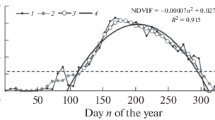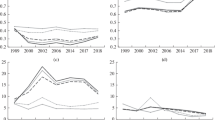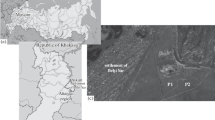Abstract
This study considers long-term dynamics of the vegetation indices derived from Landsat imagery of the period from 1989 to 2014. The mass death and damage of forests by Siberian moth occurred in dark coniferous taiga in 1994–1996. The images have covered both altered (disturbed) and background forest conditions. The case study of the forest massive is located in the model area of the Angara Taiga Region of Eastern Siberia (Krasnoyarsk krai). The values of spectral brightness of satellite images are represented by produced index images of NDVI vegetation index and shortwave vegetation index SWVI. The study employed forest-surveying materials from 1992 and data on the degrees of forest damage during the first (in 1995) and second (in 1996) year of Siberian moth outbreak. The latter was obtained by forest-pathology research using production-scale spectrozonal aerophotography. The average background values of indices have gradually decreased with the forest age or remained constant, excluding the young growth stage and 200-year-old light coniferous forests. High seasonal variability of NDVI compared to SWVI is the key to use satellite data for the timeframe of a week in June for every year to analyze long-term dynamics. We have approved the conclusion of other researchers that both the mean and the coefficient of variation of SWVI are the most informative in the evaluation of the degree of Siberian moth damage of forests. We recommend recognizing three degrees of forest damage by Siberian moth—light, moderate, and severe (continuous). Long-term dynamics of vegetation indices in disturbed forests has been marked with demutation and inhomogeneity of stand cover. Taking into account the intensity and frequency of wildfires, it is highly probable that reforestation will not occur in dark coniferous forests. Therefore, the regular satellite monitoring of the sites of Silk moth occurrence would be useful.
Similar content being viewed by others
References
Aerokosmicheskii monitoring lesov (Aerospace Monitoring of Forests), Isaev, A.S. and Sukhikh, V.I., Eds., Moscow: Nauka, 1991.
Bartalev, S.A., Ershov, D.V., and Isaev, A.S., Evaluation of forest defoliation on multispectral satellite images by decomposition of spectral mixtures, Issled. Zemli Kosmosa, 1999, no. 4, pp. 78–86.
Bartalev, S.A., Ershov, D.V., Korovin, G.N., Kotel’-nikov, R.V., Lupyan, E.A., and Shchetinskii, V.E., Information system of the Russian Federal Agency of Forestry for remote monitoring of forest wildfires: status and prospective development, Sovrem. Probl. Distantsionnogo Zondirovaniya Zemli Kosmosa, 2008, no. 5, vol. 2, pp. 419–429.
Bartalev, S.A., Kuryatnikova, T.S., and Stibing, H.J., Use of time series of satellite images of high spatial resolution for evaluation of scales and dynamics of logging of taiga forests, Sovrem. Probl. Distantsionnogo Zondirovaniya Zemli Kosmosa, 2005, vol. 2, no. 2, pp. 217–227.
Belova, E.I. and Ershov, D.V., Pretreatment of Landsat-TM/ETM+ time series of images to create cloudless composite images of localities, Sovrem. Probl. Distantsionnogo Zondirovaniya Zemli Kosmosa, 2011, vol. 8, no. 1, pp. 73–82.
Chander, G., Markham, B.L., and Helder, D.L., Summary of current radiometric calibration coefficients for Landsat MSS, TM,ETM+, and EO-1 ALI sensors, Remote Sens. Environ., 2009, no. 113, pp. 893–903.
Cherenkova, E.A., Use of satellite data for analysis of dynamics of soil moisture and status of vegetation cover of the south of European Russia in the end of 20th–beginning 21st centuries, Issled. Zemli Kosmosa, 2011, no. 6, pp. 80–87.
Cherepanov, A.S., Vegetation indices, Geomatika, 2011, no. 2, pp. 98–102.
Dottevio, C.L. and Williams, D.L., Satellite technology: an improved means for monitoring forest insect defoliation, J. Forestry, 1983, vol. 81, no. 1, pp. 30–34.
Elsakov, V.V. and Kulyugina, E.E., Vegetation cover of Yugra Peninsula affected by climate changes over last decade, Issled. Zemli Kosmosa, 2014, no. 1, pp. 60–70.
Elsakov, V.V. and Teteryuk, L.V., Role of relief in vegetation development of karst landscapes of European part of northeastern Russia, Issled. Zemli Kosmosa, 2012, no. 3, pp. 78–93.
Fraser, R.H. and Latifovic, R., Mapping insect-induced tree defoliation and mortality using coarse spatial resolution satellite imagery, Int. J. Remote Sens., 2005, vol. 26, no. 1, pp. 193–200.
Furyaev, V.V., Shelkopryadniki taiki i ikh vyzhiganie (The Taiga Silk Moths and Their Burning), Moscow: Nauka, 1966.
Gao, B.C., NDWI—a normalized difference water index for remote sensing of vegetation liquid water from space, Remote Sens. Environ., 1996, vol. 58, no. 3, pp. 257–266.
Grodnitskii, D.L., Siberian gypsy moth and prospective status of fir taiga, Priroda (Moscow), 2004, no. 11, pp. 31–40.
Grodnitskii, D.L., Raznobarskii, V.G., Remarchuk, N.P., and Soldatov, V.V., Degradation of forest stands in taiga affected by gypsy moth, Sib. Ekol. Zh., 2002, no. 1, pp. 3–11.
Im, S.T., Fedotova, E.V., and Kharuk, V.I., Analysis of the damage spots of taiga forests by Siberian silk moth according to small-scale satellite images, Vychislit. Tekhnol., 2007, vol. 12, no. 1, pp. 60–69.
Im, S.T., Fedotova, E.V., and Kharuk, V.I., Spectrophotometric satellite images in analysis of the burst of mass reproduction of Siberian silk moth, Zh. Sib. Fed. Univ., Ser.: Tekh. Tekhnol., 2008, vol. 1, no. 4, pp. 346–358.
Isaev, A.S., Kiselev, V.V., Kalashnikov, E.N., Pleshikov, F.I., and Cherkashin, V.P., GIS systems in forecasting and control of mass reproduction of forest insects, Lesovedenie, 1999, no. 5, pp. 15–23.
Isaev, A.S. and Kondakov, Yu.P., Principles and methods of forest entomological monitoring, Lesovedenie, 1986, no. 4, pp. 3–12.
Isaev, A.S. and Korovin, G.N., Large-scale changes in Eurasian boreal forests and their evaluation using satellite data, Lesovedenie, 2003, no. 2, pp. 3–9.
Isaev, A.S., Korovin, G.N., Lukina, N.V., Sukhikh, V.I., and Ershov, D.V., The catastrophic effect of anthropogenic and natural factors on forest ecosystems, in Izmenenie okruzhayushchei sredy i klimata. Prirodnye i svyazannye s nimi tekhnogennye katastrofy. Tom 4. Protsessy v biosfere: izmeneniya pochvenno-rastitel’nogo pokrova i territorial’nykh vod RF, krugovorot veshchestv pod vliyaniem global’nykh izmenenii klimata i katastroficheskikh protsessov (Change of Environment and Climate. Natural and Related Technogenic Disasters, Vol. 4: Processes in Biosphere: Dynamics of Soil-Vegetation Cover and Territorial Waters of Russian Federation, the Matter Cycle Affected by Global Climate Changes and Disastrous Processes), Zavarzin, G.A. and Kudeyarov, V.N., Eds., Pushchino: Inst. Fiz.-Khim. Biol. Probl. Pochvoved., 2008, pp. 66–79.
Kharuk, V.I., Kozhukhovskaya, A.G., Pestunov, I.A., Ranson, K.J., and Tsibul’skii, G.M., NOAA/AVHRR survey in monitoring of the bursts of Siberian silk moth, Issled. Zemli Kosmosa, 2001, no. 1, pp. 80–86.
Kharuk, V.I., Ranson, K.J., Kuz’michev, V.V., Burenina, T.A., Tikhomirov, A.Yu., and Im, S.T., Use of Landsat survey for monitoring of Siberian silk moths in Southern Siberia, Issled. Zemli Kosmosa, 2002, no. 4, pp. 79–90.
Kharuk, V.I., Ranson, K.J., Kozuhovskaya, A.G., Kondakov, Y.P., and Pestunov, I.A., NOAA-AVHRR satellite detection of Siberian silkmoth outbreaks in Eastern Siberia, Int. J. Remote Sens., 2004, vol. 20, no. 24, pp. 5543–5555.
Knizhnikov, Yu.F., Kravtsova, V.I., and Tutubalina, O.V., Aerokosmicheskie metody geograficheksikh issledovanii: uchebnik dlya studentov vuzov (Aerospace Methods Used in Geographical Studies: Manual for Higher Education Students), Moscow: Akademiya, 2011, 2nd ed.
Kogan, F.N., Vegetation index for areal analysis of crop conditions, Proc. 18th Conf. on Agriculture and Forest Meteorology, West Lafayette, IN: Am. Meteorol. Soc., 1987, pp. 103–106.
Kolomiets, N.G., Parazity i khishchniki sibirskogo shelkopryada (Parasites and Predators of Siberian Gypsy Moth), Novosibirsk: Sib. Otd., Akad. Nauk SSSR, 1962.
Kondakov, Yu.P., Mass reproduction of the gypsy moth in the forests of Krasnoyarsk krai, Entomol. Issled. Sib., 2002, no. 2, pp. 25–74.
Koroleva, N.V. and Ershov, D.V., Analysis of forest cover dynamics in Lower Angara region (Krasnoyarsk krai) over last 20 years according to Landsat data, Mater. V Vseross. konf. s mezhd. uchastiem “Aerokosmicheskie metody i geoinformatsionnye tekhnologii v lesovedenii i lesnom khozyaistve” (Proc. V All-Russ. Conf. with Int. Participation “Use of Aerospace Methods and GIS Technologies in Forestry and Economics”), Moscow: Tsentr Probl. Ekol. Produkt. Lesov, Ross. Akad. Nauk, 2013, pp. 157–160.
Kovacs, K., Ranson, K.J., and Kharuk, V.I., Detecting Siberian silk moth damage in central Siberia using multitemporal MODIS data, Int. Workshop on the Analysis of Multi-Temporal Remote Sensing Images, May 16–18, 2005, Biloxi, MS, 2005, pp. 25–29.
Kuular, Kh.B., Use of Landsat data for evaluation of wildfire squares of Uyukskii Ridge, Issled. Zemli Kosmosa, 2014, no. 5, pp. 76–82.
Metody monitoringa vreditelei i boleznei lesa: spravochnik. Tom 3. Bolezni i vrediteli v lesakh Rossii (Monitoring of Forest Pests and Diseases, Vol. 3: Diseases and Pests in Russian Forests), Tuzov, V.K., Ed., Moscow: Vseross. Nauchno-Issled. Inst. Lesovod. Mekh. Lesn. Khoz., 2004.
Myagkova, D.A. and Ershov, D.V., Identification and evaluation of drying squire of forests according to satellite data in Moscow oblast, Mater. V Vseross. konf. s mezhd. uchastiem “Aerokosmicheskie metody i geoinformatsionnye tekhnologii v lesovedenii i lesnom khozyaistve” (Proc. V All-Russ. Conf. with Int. Participation “Use of Aerospace Methods and GIS Technologies in Forestry and Economics”), Moscow: Tsentr Probl. Ekol. Produkt. Lesov, Ross. Akad. Nauk, 2013, pp. 190–192.
Peng, Y., Gitelson, A.A., Keydan, G., Rundquist, D.C., and Moses, W., Remote estimation of gross primary production in maize and support for a new paradigm based on total crop chlorophyll content, Remote Sens. Environ., 2011, vol. 115, pp. 978–989.
Potapov, P.V., Turubanova, S.A., Tyukavina, A., Krylov, A.M., McCarty, J.L., Radeloff, V.C., and Hansen, M.C., Eastern Europe’s forest cover dynamics from 1985 to 2012 quantified from the full Landsat archive, Remote Sens. Environ., 2015, vol. 159, pp. 28–43..
Rozhkov, A.S., Massovoe razmonozhenie sibirskogo shelkopryada i metody bor’by s nimi (Mass Reproduction of Siberian Silk Moth and Its Prevention), Moscow: Nauka, 1965.
Shary, P.A. and Sharaya, L.S., Change in NDVI of forest ecosystems in Northern Caucasus as a function of topography and climate, Contemp. Probl. Ecol., 2014, vol. 7, no. 7, pp. 855–863.
Silkina, O.V. and Vinokurova, R.I., Seasonal dynamics of chlorophyll and microelement content in developing conifer needles of Abies sibirica and Picea abies, Russ. J. Plant Physiol., 2009, vol. 56, no. 6, pp. 780–786.
Skakun, R.S., Wulder, M.A., and Franklin, S.E., Sensitivity of the thematic mapper enhanced wetness difference index to detect mountain pine beetle red-attack damage, Remote Sens. Environ., 2003, vol. 86, pp. 433–443.
Sukhikh, V.I., Sinitsyn, S.G., Apostolov, Yu.S., Danyulis, E.P., Zhirin, V.M., Moroz, P.I., Rukosuev, G.N., and El’man, R.I., Aerokosmicheskie metody v okhrane prirody i v lesnom kozyaistve (Use of Aerospace Methods for Nature Protection and in Forestry), Moscow: Lesn. Prom-st, 1979.
Uvarov, I.A., Ershov, D.V., Krylov, A.M., Bartalev, S.A., and Lupyan, E.A., Satellite GIS system VEGA-lesopatolog for monitoring of sanitary status of forests, Mater. V Vseross. konf. s mezhd. uchastiem “Aerokosmicheskie metody i geoinformatsionnye tekhnologii v lesovedenii i lesnom khozyaistve” (Proc. V All-Russ. Conf. with Int. Participation “Use of Aerospace Methods and GIS Technologies in Forestry and Economics”), Moscow: Tsentr Probl. Ekol. Produkt. Lesov, Ross. Akad. Nauk, 2013, pp. 312–314.
Vogelmann, J.E., Tolk, B., and Zhu, Z., Monitoring forest changes in the southwestern United States using multitemporal Landsat data, Remote Sens. Environ., 2009, vol. 113, pp. 1739–1748.
Yamburg, S.E., The use of aerial photographs in forest pathological analysis of forests, Extended abstract of Cand. Sci. (Agric.) Dissertation, Krasnoyarsk: Sib. Technol. Univ., 1980.
Zhirin, V.M., Distantsionnoe zondirovanie pri izuchenii dinamiki lesnykh ekosistem za rubezhom, Obzornaya informatsiya (Role of Remote Monitoring in Analysis of Dynamics of Forest Ecosystems Abroad: Review), Moscow: Lesresurs, 1993, no. 2.
Zhirin, V.M., Bartalev, S.A., and Ershov, D.V., Spectrometric evaluation of the status of trees in forest monitoring, in Problemy monitoringa i modelirovaniya dinamiki ekosistem (Problems of Monitoring and Modeling of Ecosystem Dynamics), Moscow: Ekoles, 1995, pp. 24–42.
Zhirin, V.M., Knyazeva, S.V., and Eydlina, S.P., The ecodynamical study of forest-forming process with space imagery, Lesovedenie, 2013, no. 5, pp. 76–85.
Zhirin, V.M., Knyazeva, S.V., and Eydlina, S.P., Dynamics of spectral brightness of the species/age structure for groups of forest types on Landsat satellite images, Contemp. Probl. Ecol., 2014, vol. 7, no. 7, pp. 788–796.
Zolotokrylin, A.N., Konyaev, K.V., and Titkova, T.B., Dependence between anomalies of vegetation index and monthly sums of precipitations in the zone of moderate and insufficient humidity, Issled. Zemli Kosmosa, 2000, no. 6, pp. 74–78.
Author information
Authors and Affiliations
Corresponding author
Additional information
Original Russian Text © V.M. Zhirin, S.V. Knyazeva, S.P. Eydlina, 2016, published in Lesovedenie, 2016, No. 1, pp. 3–14.
Rights and permissions
About this article
Cite this article
Zhirin, V.M., Knyazeva, S.V. & Eydlina, S.P. Long-term dynamics of vegetation indices in dark coniferous forest after Siberian moth disturbance. Contemp. Probl. Ecol. 9, 834–843 (2016). https://doi.org/10.1134/S1995425516070118
Received:
Published:
Issue Date:
DOI: https://doi.org/10.1134/S1995425516070118




